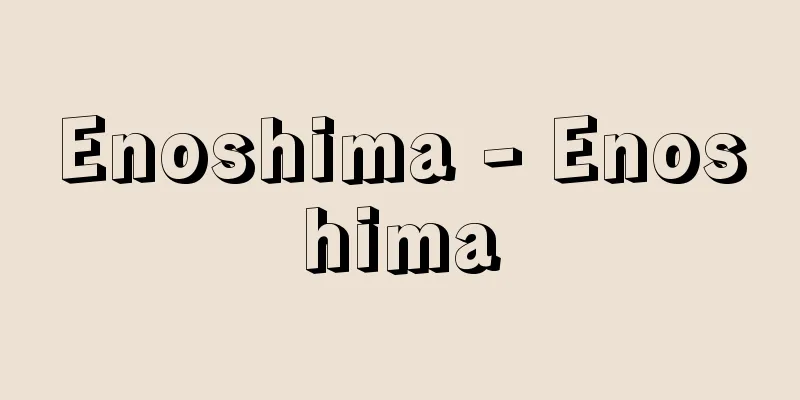Enoshima - Enoshima

|
A small island south of Fujisawa City, Kanagawa Prefecture. It belongs to Fujisawa City. Its circumference is about 4 km, and its area is 0.38 square km. The name is said to have originated from the island's shape, which resembles the character "江". The highest point is 60 meters above sea level, forming a plateau, and offers a wide view of Sagami Bay, Izu, Hakone, Mount Fuji, Tanzawa, and Mount Oyama. It connects to the historical city of Kamakura, and is the center of Shonan tourism. It is included in the international tourist route, and has been popular with both domestic and foreign visitors since early times. Geologically, Enoshima is composed of alternating layers of tuffaceous rocks and agglomerative tuff or tuff from the Miocene Tertiary Period, with the Kanto Loam layer overlying them. These layers of tuffaceous rocks were deposited on the seabed by submarine volcanoes, but later emerged above sea level due to uplift, and then separated from the Katase Plateau by fault movement to become a land-tied island. Then, due to the erosion of violent ocean waves, steep sea cliffs were formed, and many sea caves were formed along the lines of weakness created by the faults, with the innermost On'iwaya being a typical example. A sea-cut platform (reef) has also developed on the southern coast. Thus, Enoshima, with its masculine sea cliffs, sea caves, and reefs, creates a magnificent coastal scenic spot that has long been used as a subject for art. Furthermore, evergreen broad-leaved trees such as thunbergia, sudajii, white alder, and camellia grow thickly all over Enoshima, forming a dense tropical forest. Enoshima Shrine is the symbol of the island, and is also called Enoshima Benten, and is strongly worshipped by locals. In addition to praying for rain, it is said to be the guardian deity of music and the performing arts (the naked Benten holds a biwa), and to bring good luck, ward off disasters, and ward off illnesses. Since the Edo period, it has been visited by many Edo kabuki actors, lumber merchants, construction workers, firewood and charcoal merchants, and people related to the entertainment district, and the large stone and copper torii gates that were donated by these people can still be seen today. Since the early Kamakura period, Enoshima has been under the management of the monks of Tsurugaoka Hachimangu Shrine in Kamakura, and in the Edo period, the three betto priests, Iwamotobo, Kamibo, and Shimobo, managed these shrines. The wooden painted seated statue of Benzaiten (made in the Kamakura period) and the large sword are designated as important cultural properties by the prefecture. Enoshima has been a popular tourist spot since the Kamakura period, and was visited by many Kamakura samurai. In the Edo period, many Edo townspeople and travelers along the Tokaido road also stopped by. Pilgrimage routes were formed that included Mt. Oyama, Kamakura, Kanazawa Hakkei, and Kawasaki Daishi, and temple towns developed. Even today, there are inns that continue from the lodgings of pilgrim associations and regular lodgings. After World War II, observation towers and Samuel Cocking Garden were built, and in the east there is Shonan Port, a yacht harbor. Turban shells baked in a pot are a specialty. Get off at Katase Enoshima on the Odakyu Electric Railway Enoshima Line, Enoshima on the Enoshima Electric Railway, or Shonan Enoshima Station on the Shonan Monorail. The Enoshima Ohashi Bridge (completed in 1964) and Enoshima Benten Bridge (completed in 1958) are built over the sandbar. [Yukio Asaka] [References] | | | | |Along with the ancient capital of Kamakura, Enoshima is one of the most popular tourist destinations in the Shonan region. It is connected to Katase Beach (left) by the Enoshima Benten Bridge and the Enoshima Ohashi Bridge, which is for vehicles only. Enoshima Shrine (Enoshima Benten) is located on the island. Fujisawa City, Kanagawa Prefecture ©Shogakukan "> Enoshima This painting depicts people making a pilgrimage to Oitoura (Grave) at the very back of Enoshima. Benzaiten is enshrined in Oitoura, and it is said to be open to the public once every few years. Pilgrimages to Enoshima became popular among common people in Edo and nearby provinces from the middle of the Edo period, and it was a source of enjoyment for the people of Edo in particular. Utagawa Hiroshige, "Sagami Enoshima Benzaiten Opening Pilgrimage to Hongu Cave," triptych, owned by the National Diet Library . A picture of a pilgrimage to Enoshima 1853 (Kaei 6), National Diet Library Hiroshige Utagawa, "Illustrated Guide to Famous Places in the Sixty-odd Provinces, Sagami, Eno..." Source: Shogakukan Encyclopedia Nipponica About Encyclopedia Nipponica Information | Legend |
|
神奈川県藤沢市の南にある小島。藤沢市に属する。周囲約4キロメートル、面積0.38平方キロメートル。島が「江」の字の形をしていることが地名のおこりとされる。最高所は標高60メートルで台地状をなし、相模(さがみ)湾をはじめ伊豆、箱根、富士山、丹沢、大山(おおやま)などを広く展望できる。史都鎌倉と結んで湘南(しょうなん)観光の中心をなし、国際観光ルートに入れられ、早くから内外人に親しまれている。 江の島は地質上、第三紀中新世の凝灰質岩層と、集塊岩質凝灰岩または凝灰岩との互層からなり、その上に関東ローム層が重なっている。これら凝灰岩質の諸層は海底火山の噴出物が海底に堆積(たいせき)したものであるが、のち隆起運動によって海上に現れ、さらに断層運動によって片瀬(かたせ)の台地と離れて陸繋島(りくけいとう)となった。そこへ激しい海波の侵食を受けて切り立った海食崖(がい)ができ、また断層による弱線沿いにいくつもの海食洞ができたが、最奥の御窟(おんいわや)はその典型。また南岸には海食台(岩礁)も発達している。こうして江の島は男性的な海食崖と海食洞、岩礁をあわせてすばらしい海岸景勝をなし、古くから画材とされている。さらに江の島には全島にわたってタブノキ、スダジイ、シロダモ、ヤブツバキなどの常緑広葉樹がよく茂り、うっそうとした暖帯樹叢(じゅそう)をなす。江島神社は島のシンボルで、江島弁天ともいわれ、民間にも強い信仰をもち、雨乞(あまご)いのほか、音楽と芸能の守護神(裸(はだか)弁天は琵琶(びわ)を抱える)、そして開運、除災、除病などが御利益(ごりやく)とされ、江戸時代以後、江戸の歌舞伎(かぶき)役者、木材商、建設業者、薪炭(しんたん)商、花街関係者の参拝が多く、それらの寄進になる石や銅の大鳥居がいまもみられる。鎌倉初期以後、江の島は鎌倉鶴岡八幡宮(つるがおかはちまんぐう)の供僧(ぐそう)の管理下にあり、江戸時代には岩本(いわもと)坊、上の坊、下の坊の3別当がこれら諸宮を管理していた。木造彩色弁才天坐像(鎌倉時代の作)と大太刀は県指定重要文化財。 江の島は鎌倉時代からの行楽地で、鎌倉武士の訪れが多く、江戸時代には江戸町民や東海道の旅行者が多く立ち寄り、大山や鎌倉さらに金沢八景、川崎大師とあわせた参拝ルートが形成されて門前町が発達し、いまも参拝講社の宿坊や定宿(じょうやど)から続く旅館がある。第二次世界大戦後、展望塔、サムエル・コッキング苑などがつくられ、東部にはヨットハーバーのある湘南港もある。サザエの壺(つぼ)焼きが名物。小田急電鉄江ノ島線片瀬江ノ島、江ノ島電鉄江ノ島、湘南モノレール湘南江の島駅下車。砂州上には江の島大橋(1964年完成)と江の島弁天橋(1958年完成)が架けられている。 [浅香幸雄] [参照項目] | | | | |古都鎌倉とともに湘南地方を代表する観光行楽地。片瀬海岸(写真左)とは江の島弁天橋と車両専用の江の島大橋とで結ばれている。島内には江島神社(江島弁天)が鎮座する。神奈川県藤沢市©Shogakukan"> 江の島 江の島最奥の御窟(御岩屋)に詣でる人々を描いたもの。御窟には弁才天が祀られ、数年に一度、開帳されたという。江の島参詣は江戸時代中ごろから江戸や近国の庶民の間に広まり、とくに江戸の人々にとっては楽しみの一つであった。歌川広重画『相州江の嶋辨才天開帳詣本宮岩屋の図』 三枚続国立国会図書館所蔵"> 江の島参詣の図 1853年(嘉永6)国立国会図書館所蔵"> 歌川広重『六十余州名所図会 相模 江之… 出典 小学館 日本大百科全書(ニッポニカ)日本大百科全書(ニッポニカ)について 情報 | 凡例 |
<<: Stylaster profundiporus crassicaulis
>>: Green foxtail - Enokorogusa
Recommend
Sea beggar - Umikojiki
Please see the "Zegoisen" page. Source:...
Castanea dentata (English spelling) Castanea dentata
…[Yoshiharu Iijima]. … *Some of the terminology t...
Heraclianus
?‐413 A military man in the final days of the Roma...
Louis VII
1120-80 The sixth Capetian king of France. Reigned...
Aichi
[1] A district in the midwest of Aichi Prefecture....
Rakugetsudo Soushi
?-? A comic writer in the mid-Edo period. During ...
Somites - Important
When an animal's body is made up of repeated ...
Watanabe Suiha
Haiku poet. Born in Tokyo. Real name Yoshi. Eldes...
Rotation
〘noun〙① To turn around. Also, to spin. *Sihe Ruhai...
Bone fat
…The liquid portion of fats and oils extracted fr...
Barchent
…Women were the majority in the bedsheet business...
Kazunokogusa - Kazunokogusa
An annual or biennial plant of the grass family (...
Downward motion; descending current
An air current with a downward vertical component....
Lantern moss - Lantern moss
A general term for species of moss plants in the ...
Marcelino Menéndez y Pelayo
1856‐1912 Spanish literary critic and literary his...









